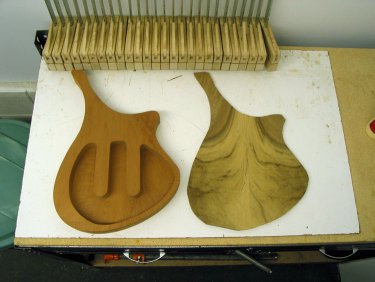Making Electric Guitars That Won’t Break Your Back

Any guitar player suffering from musculoskeletal ailments such as back pain or Repetitive Strain Injury (RSI) or a guitarist trying to practice prevention should consider the weight of his or her guitar. Whether it’s a production guitar or a custom guitar, a guitar maker or luthier can effectively build a light weight guitar using a number of approaches.
A hollowbody or chambered electric guitar is one approach. The basic process involves making a guitar body in two parts – a back section that is chambered with a second section that goes over it and forms the top.
Chambering comes in two flavors. The first involves large chambers hidden underneath the top. This approach to reducing guitar weight is very effective and results in a guitar with greater resonance and warmth. Guitar builder Scott French makes use of chambering in guitars that are in the 6 lb range.

The second involves many smaller chambers. This approach, while still very effective in reducing weight, has a smaller impact on the final tone of the instrument which may actually be preferable depending on the guitarist’s requirements for tone. Warmoth, a well established maker of guitar bodies and necks, has this as an option.

Building electric guitars from less dense woods such as alder, swamp ash, basswood, spruce and even pine is yet another approach.
Another effective approach is removing material from non-critical areas of the guitar body. Elements such as monkey grips, large control cavities and bathtub routes can help achieve this goal.
The guitar builder can also start with a thinner body. Common thicknesses for guitar body blanks are 1.75″ but that doesn’t mean a guitar can’t be thinner – keeping in mind that tremolos are a limiting factor. For example, my guitar build began with a 1.5″ thick alder blank. Black Machine Guitars builds guitars that are a mere 1.1″ thick!
All in all, we see that a guitarist need not suffer with an instrument that’s so heavy as to cause health issues. Options abound and the one’s listed here are relatively straightforward to incorporate if you build your own electric guitar.
With the guitar body consisting of more air and less wood, what do you do to balance the instruments weight to avoid a guitar that is neck heavy?
Well, unless the neck is made of stone, I would say do nothing. I have yet to see a neck heavy guitar. In fact my lightest body guitar, a hollowbody es-335 style, is completely balanced in the middle. Meaning I can balance it with one finger where the neck and body meet. I cant imagine a guitar body being lighter.
I’m confused by your comment. “Neck heavy” references poor balance and most guitars do not balance well – especially in a sitting position.
A friend of mine has a Kramer Bass it’s one of the aluminum neck era ran from 1976 to 1985… it’s the only neck heavy guitar I’ve ever had the displeasure to play. Nice tone but hard to play sitting or standing.
Guitar design with the goal of improved ergonomics requires a holistic approach, as your question suggests. My purpose in writing this particular article is to illustrate the possibilities in addressing just one of the major concerns in an ergonomic guitar design. To truly succeed, a design must take more than just this one element into account.
To accomplish this, we have to challenge ourselves to look beyond convention which is an underlying theme of my blog. Headless designs, for example, lend themselves very well to improving overall balance. The Klein design, already two decades old, went even further to address ergonomics. Yet when we think about guitars, designs that are a half century old come to mind – the Strat and the Les Paul, in particular.
However, I am not suggesting that headless designs are the only solution. New visions of the shape of the guitar can improve balance while still retaining the headstock that many prefer. Take a look at my article on Adrian Legg’s guitar for one such example. Although it is in many ways a variation of the Klein theme which in turn is a variation on the Ovation Breadwinner, it retains the conventional headstock but in a smaller format. This, in turn, reduces some of the lever effect of the neck.
A natural follow up to this article, btw, is a discussion of considerations for improving instrument balance. Keep an eye out for it.
Thanks for the comment and welcome!
Governor – Welcome to BTEG! I’m very happy to hear that the information has been of benefit. As you may have read, I’ve suffered from RSI and prior to that, many years of chronic back pain. Much of the back pain is gone and I’ve managed to bring much of the RSI under control but these are issues that I will always concern myself with. I’m glad the blog can be of help to you as well.
Robert,
Thank you so much for starting and maintaining this blog. I’m recovering from a low-back injury myself and have found the info to be very useful.
Regarding Eric’s comment:
From a purely statics point of view, just chamber the areas that would add to the torque from the neck and not chamber areas that would counteract that torque. How to do that without negatively affecting the playability or tone of the guitar requires the “holistics” that Robert mentions.
To me, that just begs the question: How would moving the controls from the traditional “six o’clock” position to the “two o’clock” position affect the tone? That would move one body cavity that adds to the neck torque to a position that would reduce this torque. So far, the only disadvantages I’ve thought of would be the additional long route for the cable socket and that it’s just “different”. One’s real and the other is “real enough” because people may have a problem with the controls being someplace different.
I really like the Warmoth chambered body. A builder told me you have to be careful making basses though, because they can easily be neck heavy.
i was looking, and i realized that my guitar is light and wondered why you would need a lighter one. but then i realized its good for people with back injuries, and disabilities, thats awesome~!
This is very informative, since I have a bad back as well. I guess chambered guitars will be the norm soon, especially with Gibson. In a way it’s a bit disturbing that the company can’t pick out naturally medium-lightweight mahogany bodies for the newer Les Pauls, and have resorted to chambering most of their solidbody guitars. I have 2 ’78 Les Paul Customs, and they’re both a little over 8 Pounds.
@Marc – Glad you found this useful. I don’t have a lot of data on the chambered Gibsons but the talk I’ve heard on forums seems generally positive.
Very light body woods are a choice too, aren’t they? Rondo is selling a Douglas strat-style made of Phoenix Tree (Paulownia) that is less than 6 pounds. Reviews suggest it is neck-heavy with a strap, though balanced on your lap.
Light body woods are certainly a way to achieve it. But as your example highlights, using these approaches with conventional body types come with its problems.
Hi there, this thread is very interesting. I am currently looking for a luthier based in Europe (I am presently based in Spain) to make me a chambered or hollow body for a Steinberger 5 bolt neck. I intend using the next incarnation of Ola Strandberg’s EGS tremolo bridge. I could use some advice too please regarding materials. Incidentally, I am also interested in using carbon fibre, perhaps with a maple top. Thank you for any advice in advance.
David
Hello,
I am currently seeing a physical therapist who is helping me with my RSI. She says my Les Paul has got to go. Can you recommend any quality guitars for playing Jazz under a thousand dollars that won’t kill my back?
My PT says that my heavy guitar has caused me to hold my guitar improperly causing strain in my wrists, hands, and shoulders.
Thank you!
Try Music Man guitars. I think they could work for jazz and they are quite light weight. I have an Axis Sport and it is about 6 pounds and well balanced. It did cost about $1,300, but it plays very well.